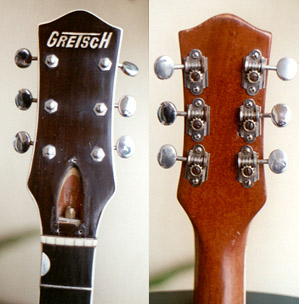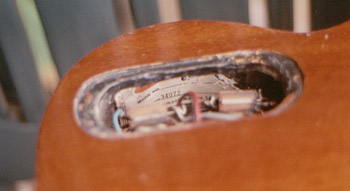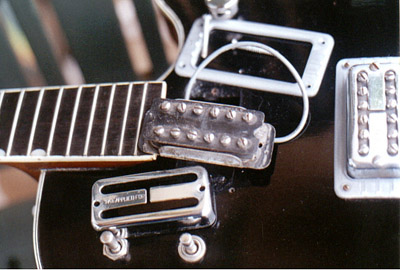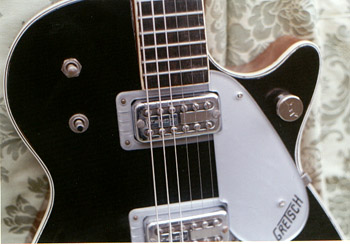
The Playmate of the Month
GRETSCH DUO-JET, 1959

The history of Jet-serie solidbodies is interesting from many points of view: not only it allows us to go back to the most significant years of US guitar manufacturing, but it also opens some interesting windows on the very special - and very 'american' - philosophy of Gretsch brand.
We are in the first half of the ’50s, and american music world is in continuous and uproarious agitation: new rhythms, new idols, new systems and new times in music reproduction and diffusion, new generations eager for fun and post-war lightheartedness, new strange instruments coming alongside with arch-top and flat-top guitars. The earliest Fender guitars shook hard the market: old and well-established brands, that initially looked conceitedly at this new trend, became soon aware that they should better follow on the same way.
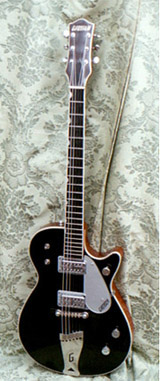 |
A strong answer came from Kalamazoo with the Les Paul model, which, in spite of being a solid-body, showed in its glued-in neck and carved top fifty years of lutherie tradition. A few years later Gretsch choose to follow a different path, which nonetheless was consistent with a long tradition: the overall shape of the new line of instruments, introduced in '54, with glued neck, and a gently curved single-cutaway body, is not too different from the Les Paul. There were many differences, though: if you hold a LP and then a Duo-Jet, you will immediately notice a great difference in weight, due to the fact that the latter is really a semi-solid-body. The body, which like the neck is made out of a single piece of mahogany, is heavily routed around pickups housing, creating a wide tone-chamber whose acoustic valence is clearly audible. Top is heat-shaped, and is made of many pressed layers of maple, mahogany, pine and spruce OR Nitron, the plastic used by Gretsch in drums-set building. |
The choice of finishes, consistently with Gretsch tradition, was aimed towards flashy colrs: early production Jets featured black Nitron of 6128 model Duo-Jet and silver-sparkle of model 6129, Silver-Jet. These guitars were joined in 1955 by Oriental Red Jet-Firebird, model 6131, and western-orange finish of 6121 Chet Atkins solidbody and 6130 Roundup with pine top. Also the hardware contibuted to add to little Gretsch guitars a touch of modernistic kitsch, made of knobs and gadgets: if the tailpiece of the Roundup was shaped like a western belt-buckle, to fit the machistic look of '50s electric cowboys, each Jet had its ‘Melita’ bridge, sado-maso boudoir tool, ‘G’-cutout chrome tailpiece, one pickup selector, two volume controls plus a master volume, and one tone control… The pikups were little DeArmond single coils, renamed in colourful Gretsch terminology nothing less than "Dynasonic". |
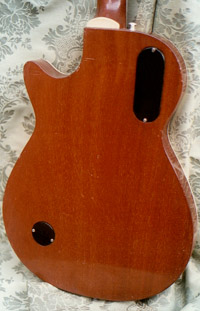 |
The guitar you see in this page, built in 1959, shows the next step of Duo-Jet evolution. In the headstock, the ‘T-Roof’ logo has replaced the script logo of the earliest years, and ‘neo-classic’ (accordingly with Gretsch terminology) ebony fretboard with half-moon pearloid inlays has already replaced brazilian rosewood with large blocks found on the earliest examples, and later ‘humptop’ inlays of George Harrison's guitar (’57). Neck and body are still of mahogany, but Nitron of the top has been replaced by a more traditional black lacquer finish. Chrome tailpiece is a little bigger, and controls on top follow the same path as other Gretsches of the time: there is'nt any more a tone pot, replaced by a selector next to pickups switch, but still there are two individual volume controls, and one master near the cutaway.
Another interesting step in Duo-Jet's evolution is the introduction of the new ‘Filter-Tron’ double-coil humbucking pickup, developed for Gretsch by Ray Butts inl 1958, and patented the following year. Following the path traced by Gibson's Seth Lover, whose pickups were patented earlier, Butt found his own way to reduce - or 'Filter' - the typical single-coil hum. So, also early Gretsch humbuckers bear no patent number on their covers, but the now legendary Patent Applied For (PAF) marking.
|
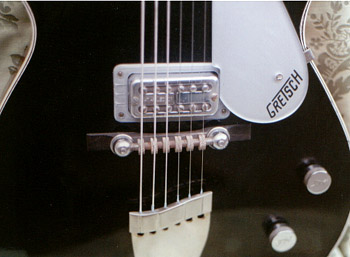 |
The guitar you see here is equipped with this early version of the pickup which has contributed with its 12 individually adjustable pole pieces and typical attack to the definition of rock, rockabilly and country sound. Pickups are surrounded by the plastic frame which can be found also in later Hi-Lo Trons equipped guitars.
Holdind this Duo-Jet. you'll be amazed for its light weight and confortable dimentions. It has a surpisingly loud acoustic sound, that cuts off extreme highs and lows, and that can be an interesting tool in a recording studio. But FilterTrons' electric soul is revealed when you plug the guitar to a tube amp: you'll hear a more defined attack with less 'singing' sustain, when compared to a Gibson humbucker from the same years. Pickup's output is not as strong, but that's not the most important feature of these instruments, highly sought-after for their trademark sound and their elegant look, which still draw to Gretsch classic guitars thousands of vintage guitar enthusiasts. |
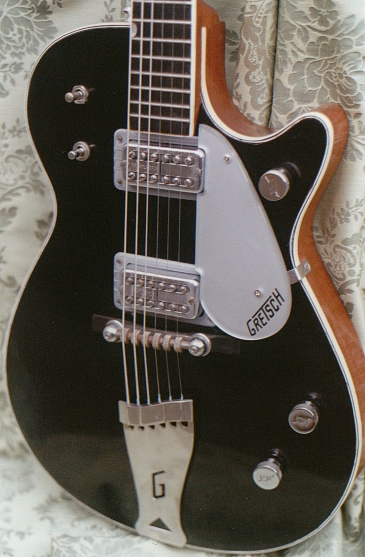 |
